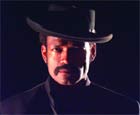
Thanks to digital satellite and cable services, it's now easier for consumers to receive a high definition signal at home than ever before. Combined with a decrease in the cost of HD receivers, the launch of new networks and a regular line-up of quality programming, the popularity of high definition television has without a doubt grown considerably over the past year.
And more networks, receivers and programming in the market leads to the need for more high definition post services. Some studios invested early in HD gear, and the increase in the popularity of the format is now helping to keep that equipment busy. Others may have been hold-outs with a wait-and-see attitude. Perhaps that's changing today, and soon they'll be taking the plunge, making their own investments in HD gear. Here's a sampling of opinions on the subject of HD.
Mike Buckner
VP, Image Editorial, New York
(www.image-group.com)
STRENGTHS: The rising consumer adoption rate of HDTV and the increased amount of HD product on the air paint a clean, crisp picture of HD's future, says Mike Buckner. "Between 2001 and 2002 the American public bought another two million HD sets, an increase of 80 percent. Prices of receivers are declining; program providers like ESPN, In Demand and Rainbow Media (Cablevision) are generating and promoting HD content, and the major networks are going forward with HD. Everyone who works in the business knows that HD is now a working format."

Robert Primes' first full-length HD feature is Getting the Man's Foot Outta Your Badasssss.
|
WEAKNESSES: "Myriad HD standards and aspect ratios can make for client confusion and difficulty in supporting projects. There must be 20 different standards with different aspect ratios. VTRs will support eight or 10 standards, but you may get something shot in yet another tape format. Clients and producers may ask for something that doesn't exist or be confused, especially if there's a mix of formats."
OPPORTUNITIES: Post houses long in the forefront of HD are the best positioned to take advantage of HD's opportunities, he says. "People who went into HD before the market came into its own now lead the way with experience."
HD's arrival also "opens up new markets for us. Indie shooters, for example, have gained the ability to produce projects that were once price prohibitive and get a quality product on the air."
THREATS: Buckner doesn't see many threats from his perspective although he notes "as early adopters we have to keep buying into high-priced equipment. HD technology is progressing at a rapid pace." An incipient threat to facilities like Image Editorial may come from program producers who invest in their own desktop HD editing systems negating the need to go to a post house."
OUTLOOK 2004: "We've definitely seen an upward swing in the whole post business. Business is better now than in a long time; a lot more production is coming into New York." Companies providing HD post "will reap the rewards" of the format.
Ken Yagoda
Executive VP, director of broadcast production & creative operations, Young & Rubicam, NY
(www.yr.com)
STRENGTHS: Ken Yagoda reports a greater tendency for the commercial market to use HD as a post production vehicle. "The flexibility you can have in post is really extraordinary," he says.
He has long felt that "familiarity and access" to HD would spark directors' creative interest. Partnering with Sony, Yagoda launched the "Dreams" series, now in its third year, to encourage directors to experiment with HD. "The idea was to take the fear out of shooting HD and to do some real creative exploration. It's about the content not the technology." The high-profile Dreams series has been so successful that directors are clamoring to be selected as shooters; some have gone on to make HD commercials.
WEAKNESSES: "HD cameras still need to be tethered. We learned to be incredibly nimble with 16mm and 35mm cameras, so we need to free HD cameras from their shackles and make them more compact." He acknowledges that HD is still evolving and such developments will come. "What's fantastic already is how many lensmakers have gotten into the HD arena."
OPPORTUNITIES: Directors who elect to work in HD will find opportunities to tell stories in new ways, says Yagoda. He points to Ananda, Will Vinton Studios' striking entry in Dreams' second-year series on the subject of joy. "I've never seen anything that uses technology in a more inviting and clever way. It mixes live action, 2D, 3D, models, compositing. People are looking for the killer [HD] app and finding it."
Y&R has been a leader in migrating spots to HD. It completed 20 to 25 HD spots this year, including an AT&T campaign and PSAs marking the bicentennial of Lewis & Clark's expedition.
THREATS: HD "is not going away" but the industry needs to "make HD standards a little more similar and work on making equipment design more user friendly."
OUTLOOK 2004: "I've given up predicting!"
Josh Touber
Partner, Chernoff Touber Associates, LA
STRENGTHS: "The main strength of the move to HD has to be the final commitment by Fox and its transition to the 720p standard. With all major networks now committed, demand for programming, and thus equipment and services, has increased," reports Touber who's partnered with Larry Chernoff in a new consulting firm.
"The R&D work that manufacturers and facilities have invested on HD workflow, process and technology these past few years has spawned bonus results in 2K and 4K technologies, which are now being applied to feature work." This includes digital intermediates, visual effects and electronic capture, he adds. "This helps to support the future model of the 'electronic laboratory,' which is perhaps the inevitable next step in the evolution of the post facility."
WEAKNESSES: Touber sees "several minor weaknesses to the conversion to HD, such as our necessary commitment to maintaining a 'legacy' path for existing television, MPEG glitches and workflow snags. Plus, with all the additional bandwidth required for HD, certain steps just take longer."
OPPORTUNITIES: "For producers, one of [HD's] best opportunities is its ability to let new players into the creative filmmaking game. For budget-conscious independent feature filmmakers it may be just the break they were looking for. For TV production companies and broadcasters, the opportunity with HD lies in the ability to utilize fully electronic techniques for production and yet maintain the visual appeal normally associated with film."
For emerging post houses, Touber sees "an opportunity to potentially grab market share from more established players by developing new post techniques based on lower cost server solutions that require significantly less initial capital investment and therefore lower rate structures. For a couple of years this may be a tremendous windfall for adventurous entrepreneurs, as long as they can hold firm on their business model and set a healthy rate structure based on the costs of their equipment rather than simply the rate of the bid next door."

|
THREATS: According to Touber, "the business is key" to HD's success. "A more fractured and declining viewing audience has resulted in lower ad revenues and licensing fees from broadcasters, which ultimately trickles down to all facets of production and post. No technology is immune from this business phenomenon, and unfortunately HD requires large amounts of infrastructure and capital re-investment at a time when client budgets are tighter than ever. The result has been a challenging price battle amongst post houses which, though temporarily beneficial to producers and the buyers of post services, continues to erode the health of the industry at a time when much more, not less capital investment is required."
OUTLOOK 2004: "The post industry has always been a challenge, suited best for entrepreneurs with tough guts!" He believes 2004 will be no exception. "It appears content demand will be increasing, especially if more cable channels begin to consider HD, so hopefully this will breathe more demand into the ultra-competitive facility environment going forward."
Robert Primes
A.S.C., Cinematographer, Hollywood
STRENGTHS: For Robert Primes, "the ability to monitor precisely is the primary artistic advantage of HD." He also likes HD's low-light capabilities, which can trim lighting budgets. But film "is not standing still," he stresses, citing the introduction of the Arricam, new Kodak stocks and Kodak's development of an advanced previewing system.
WEAKNESSES: "Most HD cameras are modified ENG cameras. I hope the next generation of cameras will be designed as more efficient production cameras with better ergonomics. Cinematographers are used to a very sophisticated camera infrastructure, which has been refined over the decades. HD cameras are currently more awkward systems."
Specifically Primes would like to see better viewfinders and increased color-bit depth. "You can't get the wonderful continuous gradations of color you get with film, although the results can still be quite beautiful. One weakness "that's improving rapidly," however, is exposure latitude.
OPPORTUNITIES: "Digital intermediates are going to be the future. They offer enormous image manipulation tools that you don't have with a contact print. They give me the opportunity to take the best photography I'm able to do under budget and time constraints and then do a polishing pass."
Improved HD cameras will offer cinematographers new opportunities. "Thomson's Viper camera and Sony's 950, which are in production now, have 4:4:4 compression and higher color-bit recording which increases quality. Dalsa and Arriflex have cameras coming with full, 35mm-size chips. Digital has proven its viability. Now people are working on new-generation equipment, and the results should be terrific."
THREATS: Primes likens film and video to a sailboat and a motor boat, respectively. "You need a fair amount of seamanship to sail a sailboat, but the ease of running a motor boat means anybody can drive it. You learn a certain amount of craft to shoot film, but video is right in front of you. There's a danger that people shooting video won't learn the craft of cinematography, resulting in a diminution of quality and emotional impact in the work."
Primes does his part to see that doesn't happen by teaching Panasonic VariCam workshops, which emphasize "some of the bold and expressive looks" achievable with modern HD cameras.
A proponent of "emotionally effective cinematography," Primes added HD to his creative toolbox in 1998. Since 1998, Primes has lensed the TV series MDs in HD, shot an HD pilot with Tom Selleck and just finished his first full-length HD feature, Mario van Peebles's Getting the Man's Foot Outta Your Baadasssss.